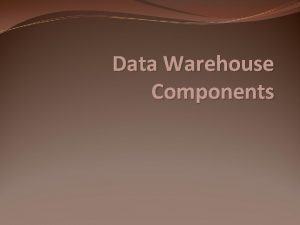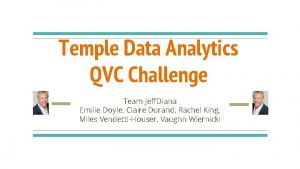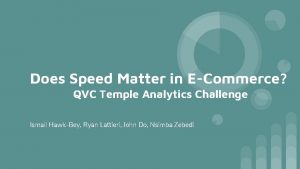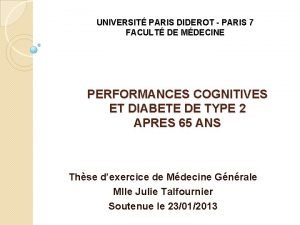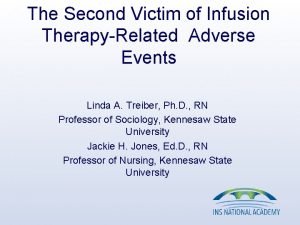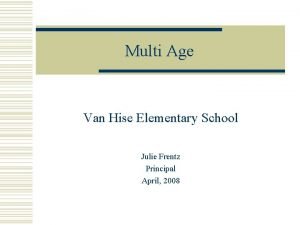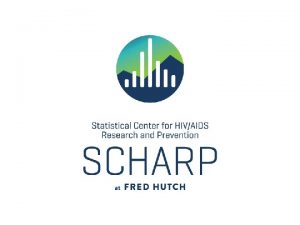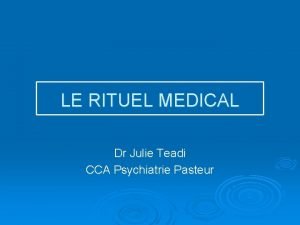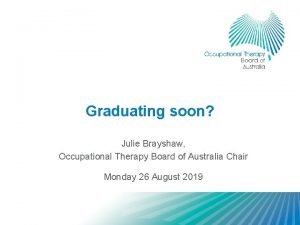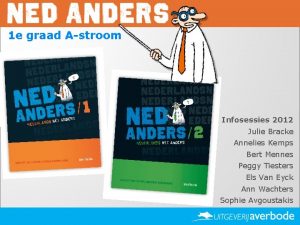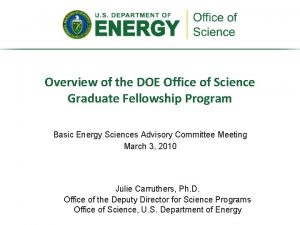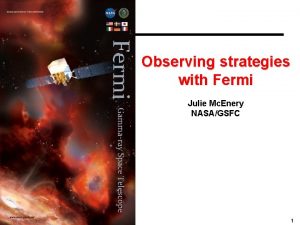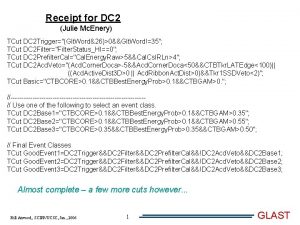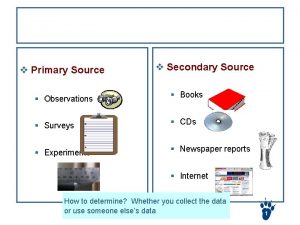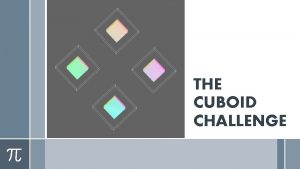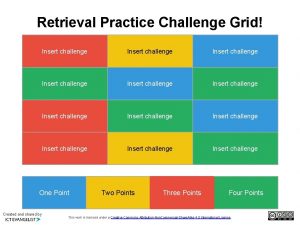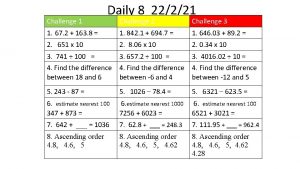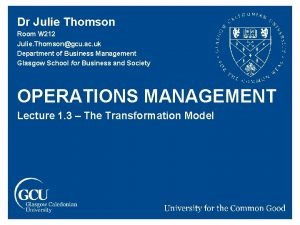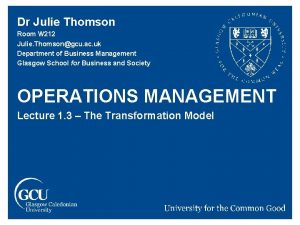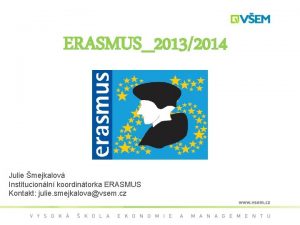Data Challenge II Julie Mc Enery 1 Source
































- Slides: 32

Data Challenge II Julie Mc. Enery 1

Source Definitions • Seth Digel, Diego Torres & Olaf Reimer on high-latitude molecular clouds, SNRs, XRBs, OB associations, Galaxies and Galaxy clusters • Omar Tibolla on specific models of HESS SNR • Max Razzano & Alice Harding on detailed definitions of pulsars • Larry Wai & Ping Wang - dark matter sources • Seth Digel, Igor Moskalenko & Andy Strong on GALPROP model calculations - diffuse emission of the Milky Way • Seth Digel - solar flare, moon, EGRET Unids • Jim Chiang, Gino Tosti, Paolo Giommi, Julie Mc. Enery - AGN • Nicola Omodei, Valerie Connaughton, David Band, Julie Mc. Enery - GRB • Luis Reyes - EBL model implementation Julie Mc. Enery 2

DC 2 Goals, requirements and purpose • 55 days of LAT data provide a deeper view of the high energy gamma-ray sky than has previously been achieved. – Results from previous gamma-ray missions provide, at best, an incomplete guide to the DC 2 sky. – Part of the challenge of DC 2 will be to figure out what was included in the sky model. – DC 2 data has a fairly realistic level of detail which will support a wide variety of both science and instrument performance studies. – Exercise the science tools – but don’t feel restricted to them – Improve the documentation and analysis software from user feedback. Julie Mc. Enery 3

Internal Communication Julie Mc. Enery 4

DC 2 Point Source Catalog analysis pipeline developed by Jean Ballet and collaborators, runs a source detection algorithm and then runs likelihood analysis to produce a table of the basic gamma-ray properties of each source. Released at the beginning of DC 2, it provided a starting point for a large fraction of the more detailed source analysis and was a reference for people doing population/source detection type studies. 380 sources Julie Mc. Enery 5

Produce LAT point source catalog – Requirement: Spectral index and flux (with associated uncertainties), location with 68% and 95% confidence ranges, flux in discrete energy bands. – Goal: Variability index, flux history, peak flux, measure of whether a source is extended. Hardness ratio vs global slope üHRi = (Fi+1 -Fi)/(Fi+1+Fi) üThe full line is theoretical value for a power law spectrum with 2 bands per decade üHR 2 (stars) looks systematically larger than HR 3 (diamonds) Julie Mc. Enery 6

Develop and test source detection algorithms – Requirement: That these algorithms are tested and compared with one another in a systematic way using the DC 2 data. • Many source detection methods developed – Stephens, Tosti, Burnett, Casandjian, Ballet, Romeo/Cillis • Compared with one another by Seth Digel Julie Mc. Enery 7

More on Catalogs Cross reference the catalog sources against other catalogs to produce identifications. Displays the catalog data in an interactive way and links in data from other wavelengths. Julie Mc. Enery Produced by ASDC group – Giommi and collaborators 8

Lightcurves and Spectra From the catalog at ASDC, there are links from each source to DC 2 data products lightcurves produced by Benoit Lott for bright sources in the catalog. These are corrected for exposure variations and are background subtracted Spectral fits for each source were produced by Luis Reyes. These are simple power-law fits, but provide a plot which can guide users to different models if needed. Julie Mc. Enery 9

Source Identification • • This was not identified as either a requirement or a goal, but there was some significant work in this area by Lonjou and Pittori. ASDC catalog webpage was a big hit with DC 2 users, very convenient way for people to browse high-level DC 2 results. Extra-galactic sources 169 Julie Mc. Enery Galactic sources 39 10 Identified sources 55 % = f (probability threshold)

Pulsars – Requirement: Determine the gamma-ray lightcurves for at least 6 pulsars which have an exact ephemeris. – Requirement: Determine timing properties of pulsars and produce gamma-ray lightcurves for at least one pulsar with an approximate ephemeris. – Goal: Determine lightcurves for more of the fainter pulsars in the DC 2 data. – Results for all the pulsars in the ephemerides were produced by Smith et al, Max Razzano and Andrea Caliandro. Julie Mc. Enery From David Smith’s talk 11

Pulsars – Goal: blind periodicity searches on candidate DC 2 pulsars Marcus Ziegler – lightcurves of pulsars withut radio data. Epoch_MET = 220838550 F 0= 5. 885928323969 F 1= -1. 306230 e-012 F 2= 1. 0 e-021 Julie Mc. Enery Epoch_MET = 220838550 F 0 = 3. 91691474178 F 1 = -1. 936137 e-013 F 2 = 6. 0 e-022 Epoch_MET = 220838550 F 0 = 3. 766282209980 F 1 = -3. 677283 e-013 F 2 = -3. 3 e-021 12

Extended sources – Goal: To identify extended sources in the DC 2 data (there are some…) – Goal: Perform spatially resolved spectroscopy. After deconvolution Vela Jr 3 EG J 1714 -3857 HESS RX-J 1713 profile Julie Mc. Enery Hiro Tajima Omar Tibolla 13

Variable sources – Requirement: Produce lightcurves for at least 20 bright sources (from the data release plan, these are the sources we will release high level data from in year 1) – Goal: look at lightcurves for many more sources Julie Mc. Enery By Benoit Lott 14

Variable Sources flux (1 day bin) flux (8 h bin) Gino Tosti – Taking lightcurves to the next level… Julie Mc. Enery 15

Variable sources – Goal: To find and study variable sources that might not be blazars (i. e. the AGN folk do not get to have all the fun) – An example of this was a study of the solar flare by Jim Chiang. Julie Mc. Enery 16

Spectral Studies – Goal: Study spectra of pulsars to determine the shape of spectral cutoffs – Goal: EBL attenuation studies (redshift dependent cutoffs) – Goal: Search for spectral signatures of dark matter PSR 0904 -5008 with EB = 25 Ge. V Galactic backgrounds PSR 0904 -5008 Galactic backgrounds Residual components Extragalactic background Omar Tibolla Julie Mc. Enery 17

Spectral Studies – Goal: Study spectra of pulsars to determine the shape of spectral cutoffs – Goal: EBL attenuation studies (redshift dependent cutoffs) – Goal: Search for spectral signatures of dark matter Luis Reyes bright blazar (BPL+EBL) Jennifer Carson residual background Julie Mc. Enery 18

Spectral Studies • Riccardo Rando found a source that appeared to consist of two components, a pulsed hard component and a soft, steady component. Refit with a composite source consisting of a power-law and a log normal component Power-law point source + background model is a very poor fit to the data Julie Mc. Enery Phase vs energy plot shows that the pulsed emission dominates above 1 Ge. V 19

Spectral Studies Sara Cutini and Dario Gasparini presented spectral studies of a sample of blazars using xspec. Purple stars DC 2 data Spectral Index = -2. 15 DC 2 sp. index = -2. 2 MRF 0253 GLAST/Max. EGRET = 0. 9 Julie Mc. Enery MRF 0294 GLAST/Max. EGRET = 1. 9 20

Gamma-ray bursts – Requirement: Perform joint spectral fits of at least one burst using both LAT and GBM data. (gtbin, rspgen, xspec) Nukri Komin Julie Mc. Enery 21

Gamma-ray bursts – Requirement: Produce preliminary GRB catalog, this should include GBM + LAT properties (goal: include LAT upper limits for GRB with no LAT detection). Nukri Komin – fit all GRB with more than 4 LAT photons, also compared xspec with likelihood fits Julie Mc. Enery 22

Gamma-Ray Bursts – Goal: Search for LAT only GRB – Searches by Nukri Komin, David Band Jerry Bonnell – There were several “lat-only” GRB to find. All the lat only GRB discoveries posted were “real” transient events (i. e. no false positives). Julie Mc. Enery 23

Gamma-Ray Bursts – Goal: Search for additional high energy components and/or afterglows Spectral analysis: spectral index= (FT 1 Viewer*): 1. 53 +/- 0. 07 (52%) (Xspec): 1. 64 +/-. 09 (75%) Omodei: GRB 08010514 – Delayed emission beginning ~400 s after the GRB trigger. Julie Mc. Enery 24

Gamma-Ray Bursts – Goal: Compare the LAT and GRB locations and quoted statistical uncertainties to study the systematic GBM localisation uncertainty. – Localisations by David Band, GBM systematic uncertainty analysis by Michael Briggs. Julie Mc. Enery 25

Other sources • Requirement: Identify at least one source that is not a pulsar, AGN or GRB (there are some that can be identified from the gamma-ray data) • Moon (Tosti, Rando) • Sun (Tosti, Chiang) Sun Moon 01/01/208 Julie Mc. Enery 26

The Moon • Several people “found” the moon, generally as an irritant that got in the way of the analysis that they set out to do – Spurious sources – Tosti, Ballet – Modulating the lightcurve of sources along the moons path – Rando • It is clear that the moon is something that we are going to have to learn how to deal with. Julie Mc. Enery 27

Diffuse sources – Goal: Study flux, spectra and spatial distribution of the galactic diffuse and compare with the diffuse model provided for source analysis. – Studied by Jean Marc Casanjian, Andy Strong and Larry Wai Julie Mc. Enery Excess due to residual cosmic-ray background 28

Diffuse sources – Goal: Study flux and spectral properties of the extragalactic background. This will include a study of the effect of residual background, contribution from galactic diffuse and resolving the point sources. – Riccardo Rando performed an analysis of the extragalactic diffuse spectrum. He produced a mapcube fits file which described the residual background which was subsequently used by several people in source analyses. Julie Mc. Enery 29

Likelihood accuracy/stabiliy • Several people examined the effect of residual background (Reyes, Carson, Cutini/Gasparini) • Rita Sambruna presented a systematic study of the behaviour of the likelihood analysis in the presence of neighbouring sources and then took a closer look at the 3 C 279 region. 1 2 3 5 6 • Julie Mc. Enery • 0 -60% MINUIT 5 -60% 10 -120% 0 -110% 20 -100% a 4 • • DRMNGB 30 -500% 20 -50% 30 -80% The wrong model 30 overestimates the flux

Cuts/IRFs and analysis methods • • • Several people discussed the details of the impacts of choices made at the higher analysis levels – photon selection region etc. A systematic study was performed by Andrea Caliandro to investigate and optimise analysis selections for pulsar studies. Nicola Omodei presented an analysis of GRB detection sensitivity for looser sets of event selection cuts. There are many more things that could be done in this area! Julie Mc. Enery 31

Summary • Coordination and interaction across the collaboration – Results of some analyses were used to refine studies in other areas • Catalog • Riccardo’s mapcube – Verifies that we are able to communicate results and ideas with one another and also that we have developed our standard data formats and software interfaces sufficiently that people can case their results in a shareable way. • The range and details of the analyses performed on the DC 2 data exceeded our expections. Julie Mc. Enery 32
 Geothermal enery
Geothermal enery Fallon sherrock smoking
Fallon sherrock smoking Component of data warehouse
Component of data warehouse Temple data analytics challenge
Temple data analytics challenge Temple data analytics challenge
Temple data analytics challenge Julie vu md
Julie vu md Julie talfournier
Julie talfournier Julie thao nurse
Julie thao nurse Dr julie beard
Dr julie beard Julie frohlich
Julie frohlich Julie frentz
Julie frentz Dr julie ngo
Dr julie ngo Dr julie hendrix
Dr julie hendrix Miss julie naturalism
Miss julie naturalism Julie august
Julie august Julie teadi
Julie teadi Julie massot
Julie massot Zazu puppet
Zazu puppet Julie anstett
Julie anstett I am proud to be an american
I am proud to be an american Julie brayshaw
Julie brayshaw Julie margenthaler md
Julie margenthaler md Bill giesler
Bill giesler Julie palais
Julie palais Julie spengel established
Julie spengel established Julie bracke
Julie bracke Julie ledger
Julie ledger Naturalistisch theater
Naturalistisch theater International association of astronomical artists
International association of astronomical artists Dermisphere
Dermisphere When i phoned my friends they play monopoly
When i phoned my friends they play monopoly Doe scgf
Doe scgf Julie wills murder
Julie wills murder


